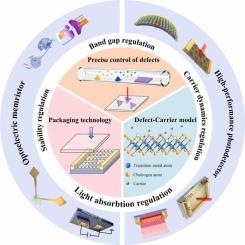Defects in 2D layered TMDCs materials: Influence on photoelectric properties and their applications
IF 6.3
2区 材料科学
Q2 CHEMISTRY, PHYSICAL
引用次数: 0
Abstract
Two-dimensional (2D) layered transition metal dichalcogenides (TMDCs) materials have the advantages of strong light-matter interaction, high carrier mobility, and adjustable band gap, which promoted the development of optoelectronic devices. However, defects will inevitably be introduced into TMDCs materials, whether naturally exfoliated or artificially synthesized. The existence of defect will change the characteristics of the material, such as band gap, light absorption, carrier mobility, etc., and further affect the performance of TMDCs-based optoelectronic devices. Therefore, it is of great significance to in-depth understanding the types, formation causes, and the effect on the photoelectric properties of materials, and apply defect engineering to high-performance optoelectronic devices. In this paper, we reviewed the research on defects in 2D TMDCs materials in recent years, focusing on the types and causes of defects, and summarizing the characterization methods of defects. Subsequently, the influence and mechanism of defects on the materials are discussed in detail. Finally, the application of defect engineering in TMDCs-based optoelectronic devices is explored. This review provides a prospective perspective for the applications of defect control in optoelectronic devices.

二维层状TMDCs材料缺陷:对光电性能的影响及其应用
二维(2D)层状过渡金属二硫族化合物(TMDCs)材料具有光-物质相互作用强、载流子迁移率高、带隙可调等优点,促进了光电器件的发展。然而,无论是自然剥离还是人工合成,TMDCs材料都不可避免地会引入缺陷。缺陷的存在会改变材料的带隙、光吸收、载流子迁移率等特性,进而影响基于tmdcs的光电器件的性能。因此,深入了解材料的类型、形成原因及其对光电性能的影响,将缺陷工程应用于高性能光电器件具有重要意义。本文综述了近年来二维TMDCs材料中缺陷的研究进展,重点介绍了缺陷的类型和产生原因,并对缺陷的表征方法进行了总结。随后,详细讨论了缺陷对材料的影响及其机理。最后,探讨了缺陷工程在基于tmdcs的光电器件中的应用。本文对缺陷控制技术在光电器件中的应用进行了展望。
本文章由计算机程序翻译,如有差异,请以英文原文为准。
求助全文
约1分钟内获得全文
求助全文
来源期刊

Journal of Alloys and Compounds
工程技术-材料科学:综合
CiteScore
11.10
自引率
14.50%
发文量
5146
审稿时长
67 days
期刊介绍:
The Journal of Alloys and Compounds is intended to serve as an international medium for the publication of work on solid materials comprising compounds as well as alloys. Its great strength lies in the diversity of discipline which it encompasses, drawing together results from materials science, solid-state chemistry and physics.
 求助内容:
求助内容: 应助结果提醒方式:
应助结果提醒方式:


